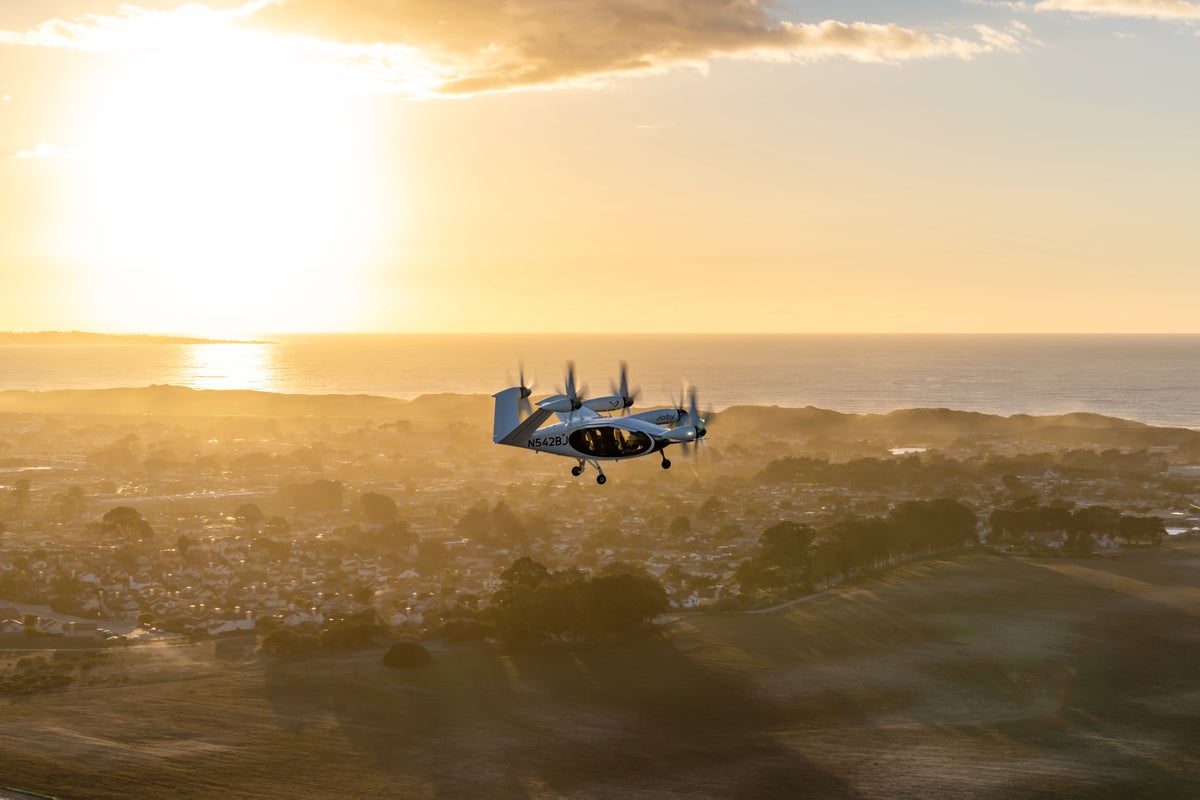When the electric air taxi revolution arrives, you probably won’t it hear coming. A remarkable feature of an electric vertical takeoff and landing (eVTOL) aircraft is how quietly it flies, scarcely noticeable amid typical city traffic sounds. Unlike a helicopter, there’s no pounding, 90-decibel “thwop, thwop, thwop.” In contrast, eVTOL aircraft use multiple small propellers that spin half as fast as a chopper’s rotor—avoiding the annoying, low-frequency sound pulses created by the big whirling blades.
Electric motors, which are quieter than helicopters’ turbine engines, also help keep any racket to a minimum. “The latest air taxi designs, such as those from leading builders like Joby and Archer, deliver a 20- to 25-decibel reduction in noise levels compared to helicopters,” says Mark Moore, the trailblazing engineer who led the development of NASA’s X-57 Maxwell electric airplane. That means that eVTOLs could be four or five times less noisy to nearby listeners. Beyond offering quieter flights, these new machines should also be significantly safer, greener and cheaper to fly than helicopters. Moore maintains that electric air taxis are uniquely suited for what the aviation industry calls urban air mobility (UAM) services, enabling normally gridlocked travelers to “take advantage of the third dimension to escape the ant trails on the ground.”
More than two dozen major eVTOL builders have been founded in the past decade, and a few are nearing commercial certification from the U.S. Federal Aviation Administration or its European counterpart, the European Union Aviation Safety Agency (EASA). Each company is working on its own homegrown aircraft design, but all have the same goal: to provide on-demand air trips no longer than 18 to 25 miles—the “sweet spot” range for first-generation, battery-electric eVTOL taxis. These short, high-speed hops could carry commuters between city centers and airports or transport cargo and packages. Militaries may want eVTOLs for casualty evacuations or logistical supply. Other potential uses include air ambulances, donor organ delivery and police transport, as well as scheduled shuttles and ecotourism trips—and, of course, personal flying cars.
[…]
Noise reduction isn’t the only perk of this propulsion approach. Many propellers offer safety redundancy that helicopters, with only one or two rotors, cannot, Moore says. If one propulsor fails, others can take the load. And unlike helicopter turbine engines that spew fossil fuel exhaust, he notes, “electric motors are low- or zero-emissions.”
The engineers and designers creating these craft couldn’t, however, simply swap turbines for electric motors. “Replacement with electric power would mean less performance in many cases,” Langford points out. “The low energy density of batteries means that electric aircraft are best suited to short-range missions—less than 200 miles, often way shorter than that.” But he adds that eVTOLs’ high efficiency and low maintenance needs can mean lower operating costs—the big draw for electric air taxi proponents.
Key among all the designs, therefore, is minimizing weight to avoid overtaxing the batteries—the weakest link among eVTOL systems—especially during takeoffs and while hovering. Many current eVTOL aircraft are being optimized to replace 60- to 90-minute car commutes with 10- to 20-minute air taxi rides flying at perhaps 150 mph. That’s why nearly all air taxi designs feature lightweight carbon-composite airframes.
There’s a lot more, and it’s fairly technical but still readable, so check it out. There are multiple types of these beasts out there and in development, and the story gets into that. There’s still no discussion of where the takeoff and landing points will be, which to me limits the reach and utility of these things; both travel times and cost of using the service are different if you have to include getting to and from the heliport and each end of the trip, as well as whatever ancillary transportation you’ll need at both ends. Cost was also not discussed, and at this time I remain convinced this will be more of a luxury service than a commodity. But we’ll see.
And we may see more of it in Houston in the near future.
Houston Airport System (HAS) announced a Memorandum of Understanding with Wisk Aero, a fully-owned subsidiary of Boeing, which recently announced a similar partnership with the city of Sugar Land. For the next year, the company will identify vertiport infrastructure at Houston’s three airports — George Bush Intercontinental Airport, William P. Hobby Airport, and Ellington Airport.
“During my time in the Texas senate, I voted for legislation supporting advanced air mobility. This public-private partnership marks a significant step forward for the City of Houston as we invest in innovative and sustainable modes of air transportation,” Houston Mayor John Whitmire says in a statement. “The collaboration underscores our commitment to pioneer advancements that will shape the future of urban mobility.”
Wisk will also develop Houston-area relationships and chart out flight paths for self-flying, electric vertical takeoff and landing (eVTOL) air taxis. The company’s Generation 6 aircraft is autonomous, but a human supervisor remotely oversees every flight.
“Houston is at the forefront of aviation and aerospace innovation, so it’s only fitting that Houston Airports take the first steps to explore the next generation of air transportation,” says Jim Szczesniak, director of aviation for Houston Airports. “Our partnership with Wisk represents a bold step towards revolutionizing air mobility not just within our city, but across the entire Greater Houston region.”
See here for some background on that. Wisk was aiming for service by 2030 for its automated eVTOLs in Sugar Land. I don’t see any dates in this article, which I presume is mostly based on a press release, so I’d assume the time frame is similar. As we know, there are some plans in the works to have some form of flying taxis in place for the FIFA World Cup in 2026. We’ll see if that actually happens.

